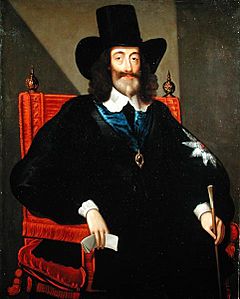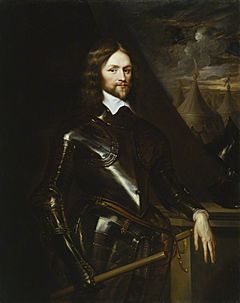Army Council (1647) facts for kids
Quick facts for kids Army Council(1647–1648) Council of Officers (1648–1653) |
|
|---|---|
| Leader(s) | Thomas Fairfax |
| Dates of operation | 1647–1653 |
| Dissolved | 20 April 1653 |
| Merger of | Agitators Grandees |
| Merged into | Privy Council |
| Country | |
| Allegiance | Parliament |
| Part of | New Model Army |
The Army Council was a special group formed in 1647. Its job was to share the ideas and concerns of everyone in the New Model Army. This army was very important during the English Civil War.
At first, the Council included top leaders like Sir Thomas Fairfax. It also had representatives chosen by the soldiers from each regiment. These representatives were called Agitators.
After some important talks called the Putney Debates in late 1647, some leaders worried about the Agitators' radical ideas. So, in 1648, the Agitators were removed from the Council. The group then became known as the Council of Officers. It was mostly controlled by the senior officers, called 'Grandees'.
Why the Army Council Was Formed

The First English Civil War started in 1642. Most people on both sides believed a king's rule was chosen by God. But they disagreed on what a "well-ordered" monarchy meant. They also argued about who should control the church.
Royalists supported the Church of England. They believed bishops, chosen by the king, should lead it. Puritans wanted to "purify" the church. They thought church leaders, chosen by their communities, should guide the king.
The term 'Puritan' covered many different groups. All wanted to reform the Church of England. Presbyterians were a large group in Parliament. They wanted the Church of England to become like the Church of Scotland.
Independents were a smaller group. They did not want any state church. Oliver Cromwell, a key leader, was an Independent. Many soldiers in the New Model Army were also Independents.
The Scottish Covenanters had control of Scotland. They joined Parliament in 1643 to stop the Royalists from winning in England. As the war went on, they saw Independents and groups like the Levellers as a bigger threat than the Royalists.
In 1646, many in Parliament thought King Charles I would have to agree to their terms after losing the war. But Charles refused to make any big changes. This frustrated both his allies and his opponents.
At this time, only a few radical groups like the Levellers wanted a republic. Parliament offered Charles their conditions, called the Newcastle conditions. These included making the Church of England Presbyterian. They also wanted Parliament to control the army and punish leading Royalists. Charles kept talking, but he never planned to agree to these terms.
How the General Council Started
Even after winning the First English Civil War, Parliament faced many problems. The country was struggling with war costs. There was a bad harvest in 1646. The plague also returned.
Most Members of Parliament were Presbyterians. They had support from London's local militias. They also had support from other armies and parts of the Royal Navy. By March 1647, the New Model Army was owed a lot of money, over £3 million. Parliament told the army to go to Ireland. They said only soldiers who agreed would be paid.
In response, each army regiment chose two representatives. These were the Agitators. They joined senior officers, known as 'Grandees', to form the Army Council. This included leaders like Sir Thomas Fairfax.
On June 4, 1647, they met near Newmarket, Suffolk. They released a statement called "A Solemne Engagement of the Army". It explained their complaints and how the Council was set up. This showed Parliament that their demands had wide support. Parliament reacted by ordering the New Model Army to break up.
The Council worried Parliament would bring Charles back without any rules. So, on June 4, they had King Charles removed from his guards. He was taken to Thriplow. There, he was given "The Heads of the Proposals". These were conditions made by Cromwell and other senior officers. They were often softer than Parliament's Newcastle Propositions, especially about religion.
This caused a split between Parliament and the New Model Army. It also created a gap between the army's senior officers and the regular soldiers. The soldiers felt the proposals were too mild. Charles saw a chance to divide his enemies and rejected the proposals. On July 26, angry pro-Presbyterian crowds forced their way into Parliament. They demanded Charles be invited to London.
In early August, Fairfax and the New Model Army took control of London. This helped the leaders regain control over the soldiers. But with most of the army near London, the Levellers gained more influence. With their help, the Agitators created a new plan for government. It was called the Agreement of the People.
This plan asked for almost all men to be able to vote. It also wanted to change voting areas. It said Parliament should have the highest power. It also called for religious freedom and an end to jailing people for debt.
At the Putney Debates in late October and early November, Agitators discussed the 'Agreement' and the 'Proposals'. Cromwell's son-in-law, Henry Ireton, spoke for the Army Council. The Levellers wanted the whole army to vote on which plan to accept. But the Council outsmarted them. They insisted on three separate meetings.
The Council used this delay to make sure the 'Proposals' were accepted. They made every soldier sign a loyalty statement to Fairfax and the Army Council. Signing meant accepting the 'Proposals'. In return, soldiers were promised all their unpaid wages. It was suggested that disagreements within the army could stop Parliament from paying them.
At the first meeting on November 15, some soldiers refused to sign. This led to the Corkbush Field mutiny. It was quickly stopped. Private Richard Arnold was tried for mutiny and shot as an example. At the other two meetings, the regiments followed orders and supported Fairfax. As a result, the Army Council became a strong political power. It was separate from both the king and Parliament.
The Council of Officers Takes Charge
Over the next few years, the Army Council changed. The elected Agitators were removed. The Council then became a group made up only of army officers. This group remained very important in the government of the English Commonwealth and during the Protectorate.
For example, when the Protectorate began, Cromwell dissolved the Rump Parliament. Ten days later, on April 20, 1653, he told the Council of State that it no longer existed. Instead, he and the Council of Officers set up a new Council of State.


